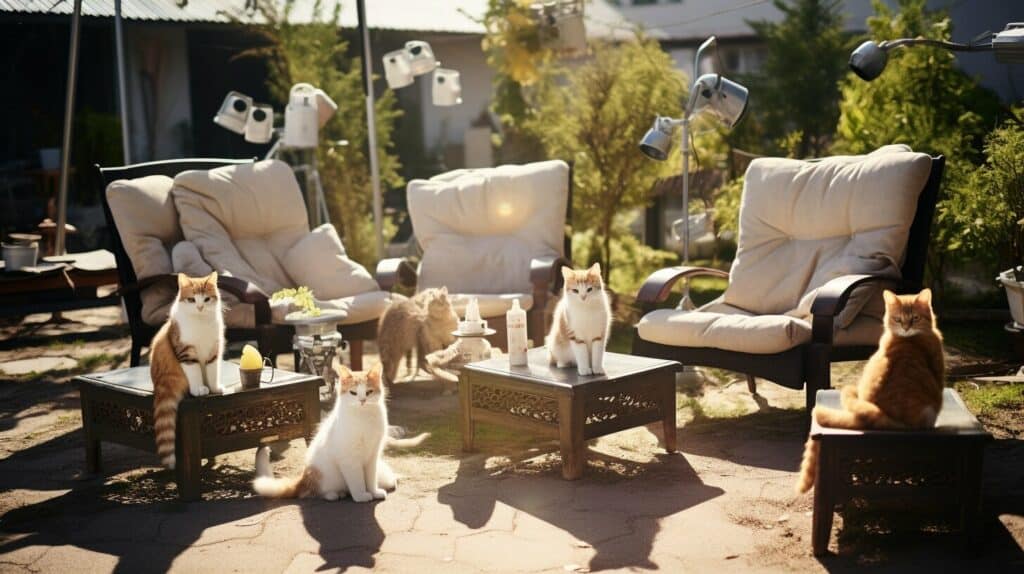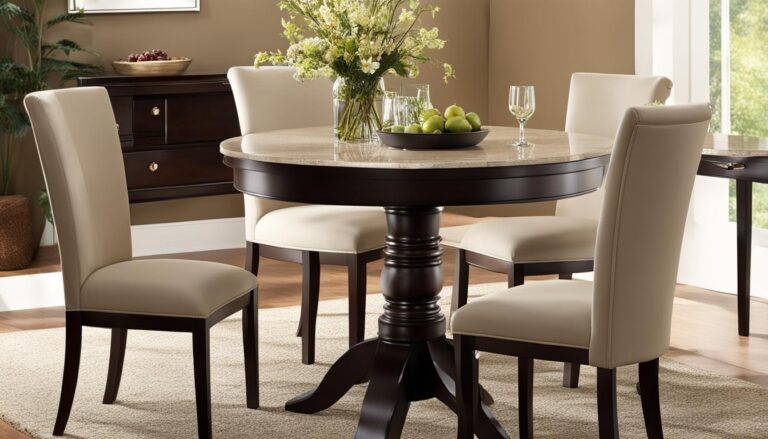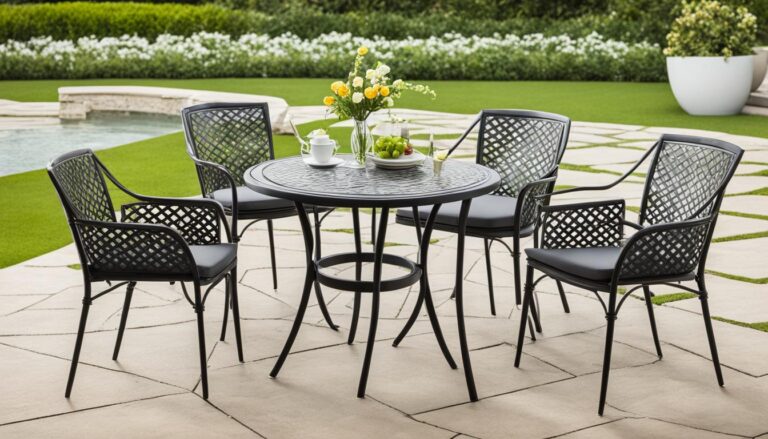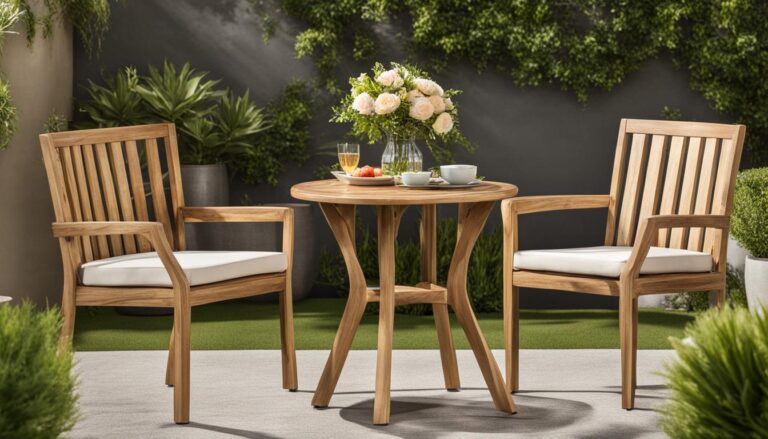Do you love spending time on your patio, but find your outdoor furniture constantly covered in cat hair and scratch marks? It can be frustrating to see your beloved patio pieces destroyed by your feline friends. Fortunately, there are effective methods for keeping cats off outdoor furniture, without compromising on their happiness and wellbeing.
In this article, we will explore various tips and tricks for preventing cats from scratching and climbing on your patio furniture. From creating alternative options to using repellents and protective measures, you can safeguard your furniture while ensuring your cats have plenty of space to play and relax.
Key Takeaways:
- Understanding cat behavior is key to effective cat-proofing techniques for outdoor furniture
- Creating cat-friendly spaces and providing alternative options are effective methods for discouraging cats on outdoor furniture
- Furniture covers and protective measures, as well as cat repellents, can help keep your outdoor furniture scratch-free
- Regular maintenance and cleaning, collaborating with neighbors, and utilizing technology or seeking professional help can provide additional solutions.
Understanding Cat Behavior
Before you can effectively cat-proof your outdoor furniture, it’s important to understand why cats are naturally drawn to it in the first place. Cats are curious and active animals that love to climb, explore, and scratch. The textures and materials commonly found on outdoor furniture – such as wood, wicker, and fabric – are especially attractive to them.
Additionally, cats often use scratching as a way to mark their territory, release energy, and groom their claws. The act of scratching also helps them stretch their muscles and keep their claws healthy. So, while scratching is a natural and necessary behavior for cats, it can be destructive to our patio pieces.
Preventing Cats from Scratching Outdoor Furniture
One effective way to prevent cats from scratching your outdoor furniture is to provide them with alternative scratching surfaces. Invest in a sturdy scratching post or pad and place it near your patio furniture. You can also encourage your cats to use it by rubbing some catnip on the surface. This will attract their attention and keep them away from your furniture.
Another option is to cover your furniture with materials that cats don’t find appealing to scratch. Aluminum foil, double-sided tape, or sandpaper can make the surface unappealing to cats. You can also use a spray bottle to squirt your cats with water whenever they attempt to scratch your patio pieces. This will help them associate the furniture with a negative experience and eventually deter them from approaching it.
Establishing Alternative Options
If you want your cats to stop using your outdoor furniture as their personal scratching posts, it’s crucial to provide them with alternative options to divert their attention. Here are some of the most effective methods for discouraging cats on outdoor furniture:
- Scratching posts: Cats love to scratch, so providing them with a designated scratching post is a great way to steer them away from your patio furniture. Choose a post that is sturdy and tall enough for them to stretch their bodies while scratching. Place the post near the furniture they tend to scratch the most and gradually move it further away as they start using it more often.
- Cat trees: A cat tree can offer multiple levels for cats to climb, scratch, and play in a designated area outside. Place it near the furniture they tend to scratch the most, and add toys or treats to make it more enticing.
- Toys: Interactive toys such as feather wands or laser pointers can be a fun way to engage with your cats and keep them entertained. Leave them in a designated outdoor space to encourage your cats to play there instead of on your furniture.
- Deterrent sprays: There are a variety of cat deterrent sprays available on the market that can be used to repel cats from outdoor furniture. These sprays often use smells or tastes that cats find unpleasant, such as citrus or mint. Be sure to choose a safe and non-toxic spray that won’t harm your cats or furniture.
- Plants: Certain plants, such as citronella or lavender, are known to repel cats. Add these plants to your outdoor space to create a natural barrier between your cats and furniture.
By providing your cats with alternative options, you can redirect their attention away from your outdoor furniture, and encourage them to use designated areas to play and scratch.
Creating Cat-Friendly Spaces
While providing alternative options can divert a cat’s attention away from your outdoor furniture, creating designated cat-friendly spaces can also be highly effective. By setting up cozy and engaging areas specifically designed for feline enjoyment, your cats will be less likely to climb on your patio pieces.
One way to create cat-friendly spaces is to provide hiding areas, such as a small tent or a cardboard box with a hole cut out. Cats love to hide and feel secure, and these simple additions can keep them happy and entertained.
Another option is to install scratching posts or pads in areas where cats typically scratch outdoor furniture. This will not only provide a suitable surface for scratching but will also prevent them from damaging your patio pieces. Additionally, incorporating catnip toys or treats into these areas can further entice your furry friends and keep them coming back.
Finally, don’t forget to consider the placement of these designated spaces. Placing them near the furniture they tend to climb on will make them more likely to choose the cat-friendly option instead. Additionally, providing water and food in these areas can make them a regular destination for your cats, further reducing their interest in your outdoor furniture.
Using Cat Repellents
If your cat just can’t seem to stay away from your outdoor furniture, you might want to consider using a cat repellent. There are many options available, both commercial and natural, that can help keep your feline friends away from your patio pieces.
Commercial Cat Repellents
One option is to use a commercially-available cat repellent. These sprays or pellets are designed to emit an odor that cats find unpleasant, but which is usually undetectable to humans. To use them, simply spray or sprinkle the repellent around the areas you want to protect. Be sure to follow the manufacturer’s instructions carefully, and keep in mind that you may need to reapply the repellent periodically.
Natural Cat Repellents
If you prefer a more natural solution, there are several substances that cats find unappealing. For example, cats generally dislike the smell of citrus, so placing lemon or orange peels around your patio furniture may help deter them. Other options include vinegar, peppermint oil, and even coffee grounds. Simply sprinkle or spray the repellent around the affected areas.
Remember, cats can be stubborn creatures, so it may take some trial-and-error to find a repellent that works for your feline. Also, keep in mind that some repellents may not be effective for all cats.
Furniture Covers and Protective Measures
If your cat is persistent in climbing on your outdoor furniture despite all your efforts, you might need to physically block their access. One of the most effective ways to do this is by using furniture covers or protective measures.
Furniture covers, such as slipcovers or tarps, can be draped over the furniture to make it less appealing to cats. These covers also keep the furniture clean and dry, protecting it from outdoor elements.
Another option is to use protective barriers such as netting, fencing, or lattice. These barriers create a physical barrier between your cat and the furniture, preventing any direct contact and making it difficult for cats to climb up.
You can also try covering the furniture with sticky tape or aluminum foil, which cats dislike the texture of. This approach can deter cats from scratching or climbing on the furniture.
It’s important to note that protective measures should not create any harm or danger to your cat. Ensure that all barriers and covers are safe and sturdy, and that there is no risk of entrapment or injury.
Training and Behavior Modification
If your cat still insists on using your outdoor furniture as a scratching post or play area, it’s time to consider training and behavior modification techniques to redirect their behavior.
One effective method is to provide your cat with an alternative scratching post or cat tree that is more appealing to them. Place it near the outdoor furniture to encourage them to use it instead. Whenever you catch them scratching the furniture, redirect them to the scratching post or tree and reward them with treats or praise when they use it.
You can also try using deterrents such as double-sided tape, aluminum foil, or citrus scents on the furniture to discourage scratching. Another option is to use a motion-activated sprayer that releases a harmless burst of water when your cat approaches the furniture.
Consistency is key when it comes to training and behavior modification. Make sure to reinforce positive behavior and redirect negative behavior every time you see it. With patience and persistence, you can train your cat to use appropriate scratching surfaces and stay off of your outdoor furniture.
Regular Maintenance and Cleaning
Keeping your outdoor furniture clean and well-maintained is an essential aspect of deterring cats from using it as their play area. Cats are attracted to scents and markings, so it’s crucial to eliminate any smells that may draw them to the furniture.
To remove any existing scent markers, try using a mixture of water and vinegar, which can help break down the odor. Alternatively, you can use a commercial odor eliminator designed specifically for outdoor furniture.
Regularly washing and cleaning your furniture is also important. Use mild soap and water to clean the surfaces thoroughly, focusing on any areas that cats commonly use for scratching or climbing.
If you have pillows or cushions on your outdoor furniture, be sure to wash or change them frequently. Cats may be attracted to the smell of the fabric and attempt to scratch or knead on it, leaving behind their scent and potentially damaging the material.
By maintaining a clean and scent-free outdoor space, you can reduce the likelihood of cats being attracted to your furniture.
Collaborating with the Neighborhood
If you’re living in a neighborhood with multiple cat owners, consider collaborating with your neighbors to address the issue of cats on outdoor furniture. It’s possible that your neighbors are also struggling with this problem, and a collective effort may be more effective than individual attempts.
You can organize a community meeting or send out a letter to all cat owners in the area, discussing the problem and suggesting collaborative solutions. You may also consider pooling resources to purchase cat-friendly equipment or hiring a professional behaviorist to provide guidance to everyone.
Remember to approach this issue with a friendly and constructive attitude. Avoid blaming or shaming other cat owners, and instead focus on finding practical and collaborative solutions that benefit everyone in the neighborhood.
Utilizing Technology
If you’ve tried all the other methods and still can’t keep your cats off your outdoor furniture, it might be time to turn to technology. Fortunately, there are several high-tech solutions available that can help deter cats from climbing on your patio pieces.
Motion-Activated Sprays
One option is to install motion-activated sprays that will startle your cat when they come near your outdoor furniture. These sprays are specially designed to emit a harmless burst of air or water when triggered by motion, scaring the cat away.
To use this technology, you’ll need to set up the spray in the area where your cat typically climbs or scratches. This can be a bit tricky since you don’t want to accidentally spray yourself or other members of your household. But with a little patience and a willingness to experiment, you should be able to find the right location and settings for your motion-activated spray.
Ultrasonic Devices
Another high-tech solution to consider is an ultrasonic device. These devices emit a high-frequency sound that is inaudible to humans but very unpleasant for cats. By placing an ultrasonic device near your outdoor furniture, you can discourage your cat from approaching without causing them any harm.
Keep in mind that some cats may become desensitized to ultrasonic devices over time, so this method may not work indefinitely. However, it can be a good short-term solution to help keep your cats off your furniture while you continue to work on other cat-proofing methods.
By combining technology with other cat-proofing techniques, you can increase your chances of successfully keeping your cats off your outdoor furniture. With a little effort and creativity, you can create a comfortable and inviting outdoor space for both you and your feline friends.
Seeking Professional Help
If you have tried everything and your cat still persists in climbing on your outdoor furniture, it may be time to seek the help of a professional. A qualified behaviorist or veterinarian can provide you with additional advice and solutions that may help you deter your pet from scratching and jumping on your patio pieces.
Behaviorists can help identify the underlying causes of your cat’s behavior and provide targeted training and behavior modification strategies. They can also help you create a cat-friendly environment that will keep your cat happy and entertained while protecting your outdoor furniture.
Veterinarians can assess your cat’s health and recommend solutions based on their specific needs. They can also provide you with prescription medication or over-the-counter products that may help deter your cat from scratching and climbing on your outdoor furniture.
Remember, seeking professional help is not a sign of failure but rather a responsible and caring way to ensure you provide your cat with the best possible care and attention.
Conclusion
Cats can be a joy to have around, but their love for climbing and scratching can damage your outdoor furniture. By implementing the tips and tricks discussed in this article, you can maintain a cat-friendly environment while protecting your patio pieces.
Remember to first understand your cat’s behavior, and then establish alternative options such as designated cat-friendly spaces. Utilize cat repellents, furniture covers, and protective measures to physically block cats’ access to outdoor furniture. It’s also important to regularly maintain and clean your outdoor furniture to deter cats from marking their territory.
If all else fails, consider collaborating with neighbors, utilizing technology, or seeking professional help from a behaviorist or veterinarian. With persistence and patience, you can keep your outdoor furniture cat-free while providing a safe and happy space for your furry companion.
FAQ
Q: How can I keep cats off my outdoor furniture?
A: There are several methods you can try to keep cats away from your outdoor furniture. Some options include using cat repellents, creating cat-friendly spaces, using furniture covers or protective measures, and employing training and behavior modification techniques.
Q: What are some effective cat repellents for outdoor furniture?
A: There are both commercial cat repellents and natural remedies that can be used to deter cats from climbing on your outdoor furniture. Commercial repellents can be sprayed on the furniture or placed nearby, while natural remedies like citrus peels or coffee grounds can be scattered around the furniture.
Q: How can I create cat-friendly spaces to divert cats from my furniture?
A: To entice cats away from your outdoor furniture, consider creating designated cat-friendly spaces in your outdoor area. Set up cozy and engaging areas with scratching posts, toys, and comfortable beds to attract their attention and provide alternative options for them.
Q: Are there any tips for using furniture covers or protective measures?
A: Using furniture covers or protective measures can physically block cats’ access to your outdoor furniture. Look for covers specifically designed for outdoor use or try creative solutions like placing sticky tape or aluminum foil on the furniture surface to discourage cats from scratching or climbing on it.
Q: How can I discourage cats from using my outdoor furniture through training?
A: Training techniques and behavior modification strategies can be employed to discourage cats from using your outdoor furniture. Use positive reinforcement to reward desired behaviors and redirect their attention to designated cat-friendly areas. Make sure to be consistent and patient in your training efforts.
Q: What are some tips for regular maintenance and cleaning to deter cats?
A: Regularly maintaining and cleaning your outdoor furniture can help deter cats. Remove any scent markings by cleaning the furniture with mild soap and water. Consider using scent deterrents like citrus sprays or vinegar to make the furniture unattractive to cats.
Q: How can I collaborate with the neighborhood to address the issue of cats on outdoor furniture?
A: Collaborating with neighbors can be an effective way to address the issue of cats on outdoor furniture. Share tips and techniques with fellow cat owners or consider community initiatives like setting up cat-friendly areas in shared spaces to redirect cats away from individual properties.
Q: Can technology be used to deter cats from outdoor furniture?
A: Yes, technology can be utilized to deter cats from outdoor furniture. Motion-activated sprays or ultrasonic devices can be effective in keeping cats away. Set up these devices near the furniture or in areas where cats are likely to approach.
Q: What should I do if all my efforts have failed, and I need professional help?
A: If all your efforts to keep cats off your outdoor furniture have failed, it may be necessary to seek professional help. Consult a qualified behaviorist or veterinarian who can provide additional advice and solutions tailored to your specific situation.







